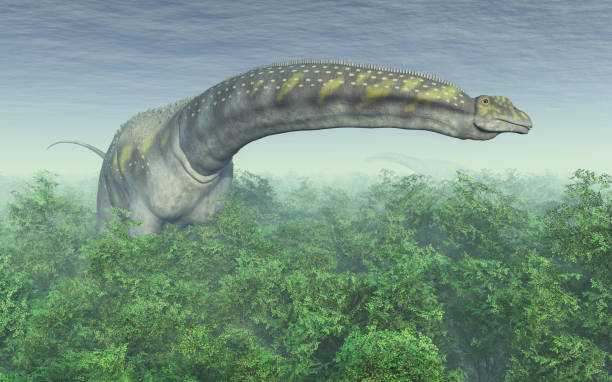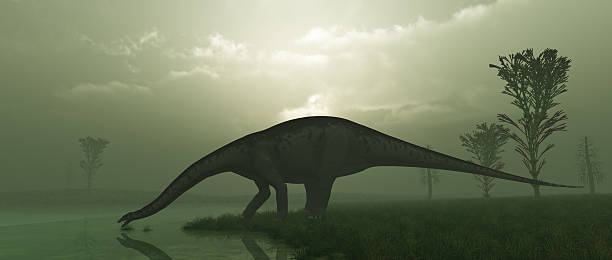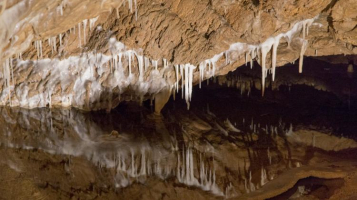Top 8 Biggest Dinosaurs
Dinosaurs were gigantic, amazing creatures that inhabited the Earth for millions of years. Although some were the size of chickens, such as Velociraptors, ... read more...others, such as Quetzalcoatlus, were higher than giraffes. Some dinosaurs weighed 50 tons or more and grew to be over 100 feet long before being wiped off by a horrific asteroid collision! Today, let's look at the biggest dinosaurs in history.
-
Dreadnoughtus is a titanosaurian sauropod dinosaur genus with just one species, Dreadnoughtus schrani. D. schrani is known from two fragmentary skeletons recovered in Upper Cretaceous (Campanian to Maastrichtian; roughly 76-70 Ma) rocks of Argentina's Cerro Fortaleza Formation. It is one of the biggest terrestrial vertebrates known, with the juvenile type specimen attaining a total body length of 26 meters (85 feet) and having the highest mass of any land animal that can be computed with fair accuracy. D. schrani has the most complete skeletons of any enormous titanosaurian.
Dreadnoughtus schrani's weight was approximated using Equation 1 of Campione and Evans (2012), which allows the body mass of a quadruped to be determined based only on the circumference of the humerus and femur. Using this scaling equation, they determined that the Dreadnoughtus specimen weighed around 59.3 tonnes (58.4 long tons; 65.4 short tons).
Gregory S Paul responded to Lacovara et al., pointing out that the error margins for calculations based on limb bones are enormous; applying the same equation, the Dreadnoughtus type specimen may have weighed anywhere between 44 and 74 tonnes (43–73 long tons; 49–82 short tons). Paul calculated as low as 26 tonnes using volumetric approaches based on a more realistic skeleton repair (26 long tons; 29 short tons).

DeviantArt 
Drexel University -
Patagotitan is a titanosaurian sauropod dinosaur genus found in the Chubut Province of Patagonia, Argentina. Patagotitan mayorum, originally revealed in 2014 and legally named in 2017 by José Carballido, Diego Pol, and colleagues, is the only species known from several individuals. Contemporary research estimated the type specimen, a young adult, to be 37 m (121 ft) long with a weight of 69 tonnes (76 short tons), subsequently corrected to 55-57 tonnes (61–63 short tons).
Patagotitan, like other titanosaur sauropods, was a quadrupedal herbivore with a long neck and tail that was renowned for its size. News sources in 2014 claimed size estimations of 40 m (131 ft) long and 77 tonnes (85 short tons); science journalist Riley Black cautioned in 2014 that it was still too early to establish size estimates with the desired scientific precision. Patagotitan mayorum's species description was published in 2017, with an estimated length of 37 m (121 ft) and an approximate weight of 69 tonnes (76 short tons) when using a scaling equation, and 44.2-77.6 tonnes (43.5-76.4 long tons; 48.7-85.5 short tons) when using a volumetric method based on 3D skeletal models.

illustrators.ru 
Pinterest -
Argentinosaurus is a genus of gigantic sauropod dinosaurs that lived in what is now Argentina during the Late Cretaceous era. Argentinosaurus is one of the biggest known terrestrial beasts of all time, maybe the largest, reaching 30-35 metres (98-115 ft) in length and 60-75 tonnes (66-83 short tons) in body mass, despite only being known from fragmented bones. It belonged to the Titanosauria, the main group of sauropods throughout the Cretaceous period. Many paleontologists believe it to be the largest dinosaur ever and maybe the longest animal ever, however neither claim has been proven.
A farmer unearthed the first Argentinosaurus bone on his land near Plaza Huincul in 1987. In 1989, an excavation headed by Argentine palaeontologist José Bonaparte yielded seven back vertebrae and fragments of a sacrum—fused vertebrae between the back and tail vertebrae. A whole femur (thigh bone) and the shaft of another are also on display. Bonaparte and Argentine palaeontologist Rodolfo Coria described Argentinosaurus in 1993; the genus has just one species, A. huinculensis. The generic name Argentinosaurus means "Argentine lizard", while the specific name huinculensis alludes to the location where it was discovered, Plaza Huincul.

istockphoto 
istockphoto -
Saltasaurus (meaning "lizard from Salta") is a saltasaurid dinosaur genus from Argentina's Late Cretaceous epoch. Saltasaurus was a small sauropod with a short neck and stubby limbs, however it was nevertheless hefty by contemporary standards. It was the first sauropod genus known to have armour made of bone plates buried in its skin. These microscopic bony plates, known as osteoderms, have since been discovered on additional titanosaurians. The species was first described in 1980, and it is considered small compared with other titanosaur species, measuring only 12.2 to 12.8 meters (about 40 to 42 feet) long and weighing slightly under 7 metric tons (about 7.7 tons).
Saltasaurus' teeth were cylindrical with spatulate tips. Saltasaurus has a small neck and truncated neck vertebrae. The centra of the vertebrae in the center of its tail were lengthened. Saltasaurus possessed small depressions in the vertebral lateral fossae called pleurocoels. Malawisaurus, Alamosaurus, Aeolosaurus, and Gondwanatitan all have fossae that look like shallow depressions. Venenosaurus featured depression-like fossae as well, but its pleurocoels were deeper into the vertebrae, separated into two chambers, and extended further into the vertebral columns. The spinal bone of Saltasaurus was mainly cancellous, with bigger air pockets present. The limbs were small and stubby, particularly the hands and feet. Saltasaurus' radii were more robust than Venenosaurus'. The stomach was quite large.

istockphoto 
istockphoto -
Rapetosaurus is a titanosaurian sauropod dinosaur genus that existed in Madagascar between 70 and 66 million years ago, near the end of the Cretaceous Period. Rapetosaurus krausei is the only species that has been recognized. Rapetosaurus, like other sauropods, was a quadrupedal herbivore with estimated lengths of 15 metres (49 ft). Rapetosaurus was a classic sauropod, with a short and thin tail, a long neck, and a massive, elephant-like bulk. It has a diplodocid-like head, with a long, narrow snout and nostrils on the top of its skull. It was a herbivore with short, pencil-like teeth that were useful for tearing leaves off trees but not for eating.
Rapetosaurus, known as the single species Rapetosaurus krausei, was the first titanosaur discovered with an almost totally entire skeleton, complete with head. It has contributed to the resolution of several tough, century-old classification difficulties within this broad group of sauropod dinosaurs, and it serves as a useful foundation for the reconstruction of other titanosaurs known solely from incomplete petrified remains. Kristina Curry Rogers and Catherine A. Forster announced their discovery in the scientific journal Nature in 2001. A virtually entire skeleton of a youngster was discovered, together with fragmentary remains of three more people.

istockphoto 
istockphoto -
Austroposeidon is a titanosaurian sauropod dinosaur genus from Brazil's Late Cretaceous Presidente Prudente Formation. Austroposeidon magnificus is the only species found there (meaning "Magnificent Southern Poseidon"). Palaeontologist Llewellyn Ivor Price found the specimen in the Campanian-Maastrichtian Presidente Prudente Formation of the Bauru Group in 1953, but the bones were not documented until 2016. According to the excellent sandstone in which the specimen was discovered, the animal was most likely preserved by a crevasse splay on a floodplain. Unfortunately, the location where the specimen was discovered has since been destroyed by urban expansion.
Austroposeidon was a gigantic sauropod found in Brazil, with the one known specimen, an adult, measuring around 25 meters in length (82 ft). Austroposeidon was a titanosaur because the vertebrae lack hyposphene-hypantrum articulations, the cervical and dorsal vertebrae lack forked neural spines, and the internal bone texture is camellate (punctuated by many small air chambers).
Austroposeidon was confirmed to be a new genus based on a number of autapomorphies (traits unique to known fossils) in the vertebrae: the thirteenth cervical vertebra has columnar centropostzygapophyseal laminae, and its rear centrodiapophyseal lamina splits into two prongs; the first dorsal vertebra has front and back centrodiapophyseal laminae that curve downwards and outwards, and its diapophysis stretches down to the top margin of the centrum; and the frontmost part of the spinoprezygapophyseal laminae forks in the dorsal vertebrae positioned towards the back of the torso. Austroposeidon also has a rare mix of additional vertebrate characteristics not found in other titanosaurs.

blogspot.com 
pinterest.com.mx -
After earlier digs at a location about 300 kilometers (186 miles) southwest of Cairo, Egypt, found a gigantic 1.69-meter- (5.5-foot-) long femur (thighbone) and a collection of broken shoulder blades, front limb bones, teeth, and vertebrae, Paralititan stromeri was named in 2001. The finding of such a huge femur led many paleontologists to claim that Paralititan was as enormous as Argentinosaurus. The titanosaur's length and weight are estimated to be between 25 and 30.5 meters (82 and 100 ft), with a weight of 60 to 75 metric tons (about 66 to 83 tons). Some 94 million years ago, Paralititan plied the Cretaceous Period's mangrove wetlands.
Scott Hartman predicts a giant creature that is still smaller than the largest titanosaurs like Puertasaurus, Alamosaurus, and Argentinosaurus. Gregory S. Paul estimated its length to be 20 meters (66 feet) and its weight to be 20 tonnes in 2010. Holtz provided a length of 32 meters (105 feet) and an estimated weight of 65.3-72.5 tonnes in 2012. It was estimated to weigh 50 tons in 2016 using methods that estimate body mass based on the circumference of the humerus and femur of quadrupedal mammals (55 short tons). Gregory S. Paul predicted Paralititan to be between 30-55 tonnes in 2019.

Pinterest 
Pinterest -
Supersaurus is a genus of diplodocid sauropod dinosaurs that existed in North America during the Late Jurassic era. Vivian Jones of Delta, Colorado, identified the type species, S. vivianae, in the middle Morrison Formation of Colorado in 1972. The fossil remnants were discovered in the Brushy Basin Member of the formation, which dates from 153 to 145 million years old.
This mammal existed around 153 million years ago. Experts had estimated that this species may grow to reach up to 141 feet long, but they have now revised their estimate to 105-138 feet. Supersaurus was the world's biggest dinosaur in either case. It did not, however, have the huge weight that one would anticipate from such a lengthy monster. Because the Supersaurus fossils are in superb condition, current estimations for the dinosaur's length have reached 120 feet or 40 meters, and may have been closer to 140 feet.
Another example of moving information: if further evidence is discovered, a virtually legendary dinosaur might push the Argentinosaurus out of third place in terms of size. The Bruhathkayosaurus fossils discovered in India included a leg, hip, and tail, and its estimated size was over 115 feet long and 80 tons. The fossils, which were described in 1987, have subsequently decomposed.

Pinterest 
flickr.com





























